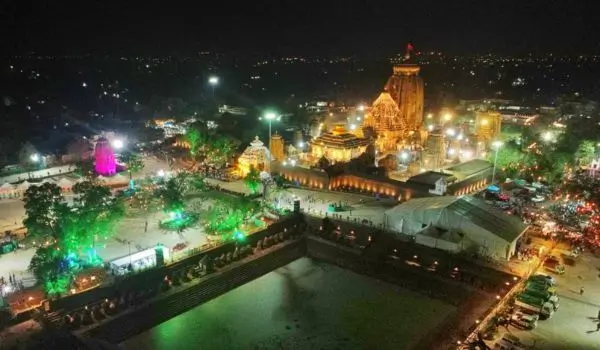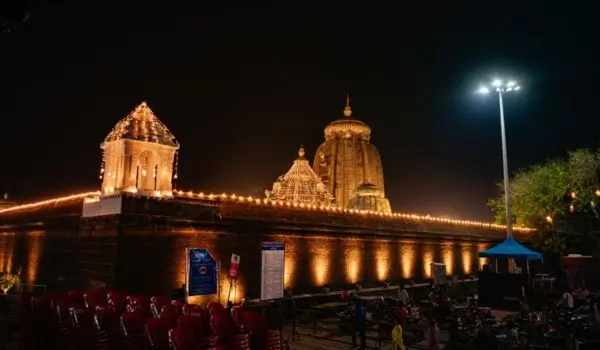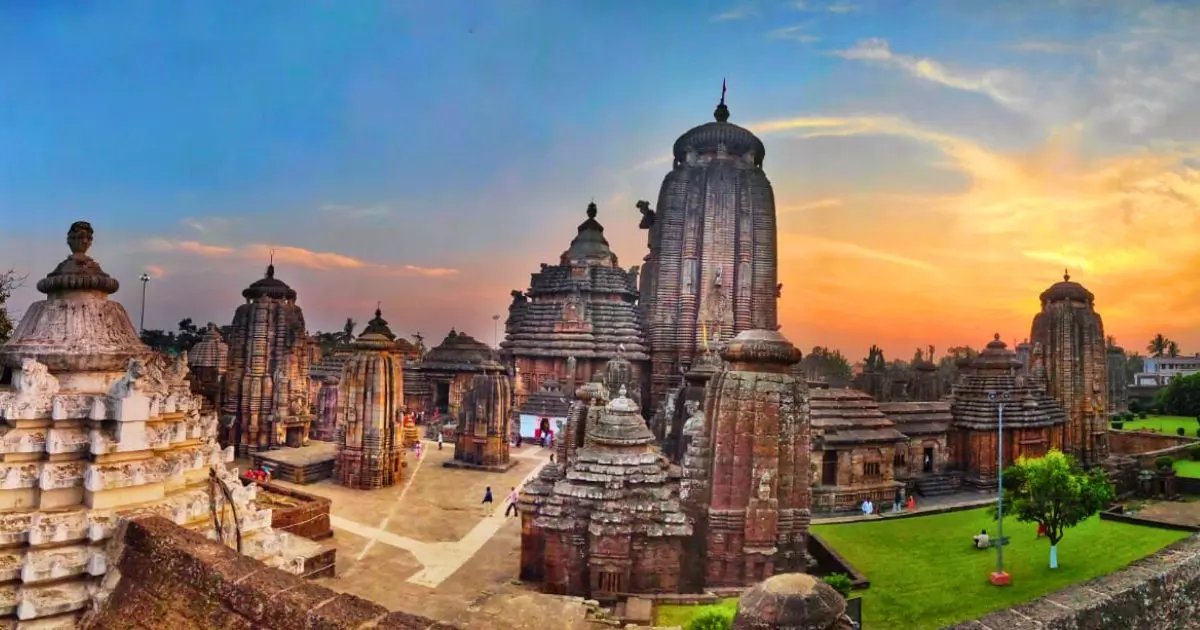Lingaraj Temple, a resplendent edifice gracing the vibrant city of Bhubaneswar, Odisha, is a living testament to the cultural and religious tapestry that has woven itself through the fabric of time.
Built over 1400 years ago by the visionary King Yayati I of Somavansh, this sacred abode is dedicated to the celestial form of Lord Shiva known as Tribhuvaneshwar, the Lord of the three worlds.
Page Index
Architectural Significance

The architectural splendor of Lingaraj Temple is a visual feast, reflecting the distinctive Kalinga and Oriya styles. Ascending towards the heavens, the temple’s upper structure, resembling a grand pyramid, is adorned with an inverted bell and a Kalash, capturing the gaze of every beholder. This enduring masterpiece stands as a testament to the skill and artistry of its ancient builders.
Nestled in the heart of Bhubaneswar, the Lingaraja Temple stands as a towering testament to the spiritual and architectural heritage of Odisha. As the largest temple in Bhubaneswar, its central tower soars to an impressive 180 feet (55 meters), dominating the skyline and beckoning visitors into a realm where history, legend, and divine worship converge.
This sacred marvel epitomizes the Kalinga architecture, a distinctive style that reached its zenith during the medieval stages of architectural evolution in Bhubaneswar. Believed to have been originally constructed by kings of the Somavamsi dynasty, the temple boasts later additions from the Ganga rulers, encapsulating the rich cultural tapestry of the region.
The Lingaraja Temple is a masterpiece of the Deula style, comprising four integral components: vimana (housing the sanctum), jagamohana (assembly hall), natamandira (festival hall), and bhoga-mandapa (hall of offerings). Each element rises in height, creating a visually striking ensemble that reflects the architectural prowess of its builders.
Within the temple complex, a grand total of 108 shrines dot the landscape, encapsulated by a sprawling compound wall that underscores the sacredness of this hallowed space.
Bhubaneswar, often referred to as Ekamra Kshetra, finds its divine significance in the Lingaraja Temple. According to the Ekamra Purana, a 13th-century Sanskrit treatise, the deity of Lingaraja was originally situated beneath a mango tree, known as Ekamra. This historical narrative adds a layer of mystique to the temple, connecting it to the very roots of the city’s religious identity.
Unlike many other temples in Bhubaneswar, the Lingaraja Temple is a vibrant center of worship, maintaining active religious practices. The temple’s intricate sculptures and architecture provide a glimpse into the region’s cultural evolution, with added images of Vishnu reflecting the influence of the Jagannath sect that gained prominence during the rule of the Ganga dynasty.
At its core, the Lingaraja Temple is a sanctum devoted to the worship of Lord Shiva, with the central deity, Lingaraja, commanding reverence and devotion. As we embark on a journey through the history, architecture, and spiritual significance of this revered temple, we unravel the layers of time that have shaped it into a living symbol of Odisha’s profound cultural and religious heritage.
Legends and Mythology

The mystical aura surrounding Lingaraj Temple is adorned with legends, one of which recounts the heroic victory of the fierce Goddess Parvati over the demons ‘Litti’ and ‘Vasa.’
Following this triumph, the goddess, fatigued and thirsty, led to the creation of a divine well by Lord Shiva. This well, now revered as Bindu Sagar Sarovar, surrounds the majestic Lingaraj Temple, making it a pivotal site for followers of the Shaiva sect.
A Dual Abode
Surprising and intriguing, Lingaraj Temple reveals a unique duality within its sacred walls. While ostensibly dedicated to Lord Shiva, the temple gracefully hosts Lord Vishnu in its upper half, embodied in the form of Shaligram. This harmonious coexistence symbolizes the unity and interconnectedness of the diverse facets of the divine.
The Sacred Linga
At the heart of Lingaraj Temple lies a sacred symbol of divine energy — a self-manifested Shivalinga crafted from granite. This unique linga, eight feet in thickness and one foot in height, holds a profound belief: that it encapsulates the essence of all the 12 Jyotirlingas scattered across India. It is this inclusive nature that bequeaths the temple its reverential name — Lingaraj.
Four Sacred Quarters
The temple’s architectural layout is a sacred journey in itself, divided into four significant quarters. The sanctum sanctorum, Garbha Griha, cradles the main deity. Yagya Shailam, Bhogmandap, and Natyashala form the remaining quarters, each playing a distinctive role in the ceremonial and cultural practices observed by the devoted pilgrims.
A Spiritual Odyssey
Pilgrims embarking on a spiritual odyssey at Lingaraj Temple follow a ritualistic path. The journey begins with a purifying bath in the holy Bindusarovar, progressing to the darshan of Anant Vasudev, Ganesh puja, and the veneration of Gopalan Devi.
Nandi, the revered mount of Lord Shiva, is worshipped before the culmination of the spiritual sojourn with the sacred sighting of Lingaraj Maharaj.
In conclusion, Lingaraj Temple, with its myriad legends, architectural opulence, and spiritual profundity, stands as a timeless bastion of devotion and cultural richness.
As visitors traverse its sacred corridors and contemplative spaces, they delve into a profound exploration of time and mystery, embracing the spiritual resonance that Lingaraj Temple exudes, transcending the boundaries of mortal existence.


